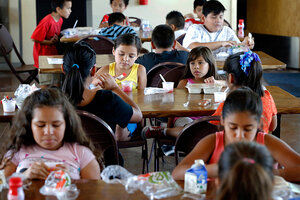Child poverty rate declines in America for first time since 2000
The poverty rate for children fell nearly 2 full percentage points last year, according to the US Census Bureau.

Children eat a free lunch at the Phoenix Day @ Central Park Youth Program in downtown Phoenix, July 22, 2014. The grant-based lunch and dinner program provides free meals to children ages 5 to 18 in the immediate neighborhood surrounding the facility.
Matt York/AP
Washington
Poverty in America declined in 2013, and the poverty rate went down faster for children than for adults – which is notable not only because they are children but also because the poverty rate for children has long been higher than for adults.
The poverty rate for children fell nearly 2 full percentage points last year, from 21.8 percent to 19.9 percent, according to the US Census Bureau. The poverty rate for all Americans also declined, to 14.5 percent from 15 percent a year before.
It was the first meaningful decline in poverty for children since 2000, and for the overall population since 2006.
The declines are due largely to an improving job market – which has lifted the living standards not only for the newly employed but also for their children.
“Every child in this country matters. So while it is significant that child poverty decreased in this single year, the real takeaway is that it demonstrates poverty is not unsolvable,” Hannah Matthews of CLASP, a nonprofit group seeking to improve conditions for low-income people, wrote after the Census released the new numbers.
There’s room for a lot more progress. The US poverty rate is still above 2007 levels, and some 45 million Americans remain in poverty, about one-third of those being children.
The recent gains have been a long time coming. In the aftermath of the two most recent recessions, which began in 2001 and 2007, the revival of the job market has been notably slower than in past economic cycles. The poverty rate, especially for children, has echoed that challenge by remaining above pre-recession levels for longer than in past recoveries.
That pattern could be due partly to changes in the labor market, as forces such as globalization and technological change make it harder to quickly replace the jobs that disappear in a recession. High household debt, meanwhile, has held back the revival of consumer spending.
Some economists say another reason poverty has lingered at elevated levels is the widening of income inequality, which means the gains of economic growth are less widely shared than in the past.
Still, the data represent very important good news. And the improvement has probably continued in 2014 – something that next year’s Census report should capture.
Last year, for children, an alternative Supplemental Poverty Measure was about 2 percentage points below the Census’s traditional measure, also an encouraging sign. One reason for the difference in the two measures is that the alternative Census gauge factors in the impact of Supplemental Nutrition Assistance Program (SNAP, formerly known as food stamps) on family incomes.
By both measures, the poverty rate has looked high for several years. The alternative measure hasn’t been released yet for 2013.
How can more progress be made?
Continued gains for the overall economy are a vital channel. Policies that strengthen economic growth or bolster support for low-income families could help.
“Top among the policies that will help working parents is making child care more affordable,” Ms. Matthews of CLASP says. “Congress is expected to pass legislation very soon to improve child care quality and make receipt of child care assistance a smoother process for parents…. We also need additional resources to expand access to child care assistance.”
On the conservative side of the political spectrum, Republican Rep. Paul Ryan of Wisconsin has proposed attacking poverty by encouraging a fund-what-works approach to social-welfare programs – including granting more money and flexibility to states, which in turn could partner with local nonprofit groups “and provide personalized aid through case management.”

